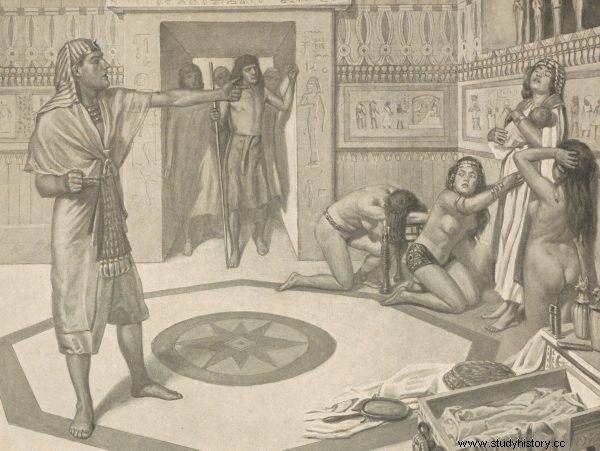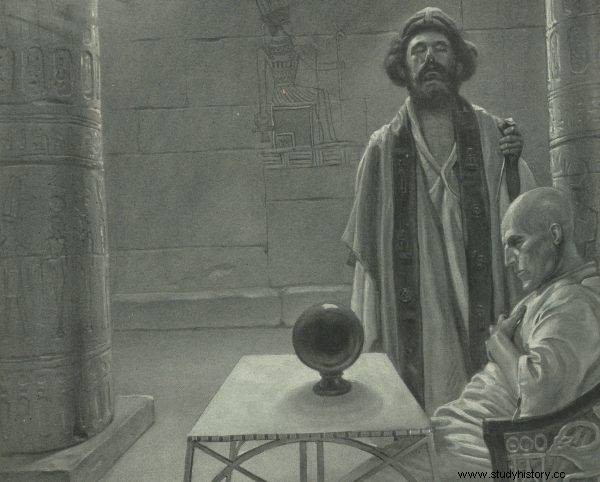Bolesław Prus in "Pharaoh" created an extremely suggestive image of ancient Egypt. However, how much historical truth is in this novel and what is mere fiction?
The rebellious Ramses XIII, young and ambitious, wishing to pursue daring goals, defeat his enemies and rebuild the former power of Egypt, and above all - to limit the influence of priests. On the other extreme, almighty Herhor, the high priest and the gray eminence actually ruling the country. These are two characters on which Bolesław Prus weave his extremely suggestive image of ancient Egypt, successfully transferred to the screen thanks to Jerzy Kawalerowicz. However, how much historical truth is there in the novel by one of the greatest Polish writers?
At first glance, it can be said:not much. After all, neither Ramses XII, nor his son Ramses XIII, nor the priest Pentuer, the Phoenician priestess Kama, nor the Lycaon look-alike existed. The only historical figure of "Pharaoh" is Herhor. Seemingly it is not much, and yet Bolesław Prus, even if he made up most of the things, was based on the historical knowledge of the time. As befits a writer of realistic prose, the author took care of a sufficiently in-depth query.

Illustration from "Pharaoh" by Bolesław Prus
At that time - that is, in the second half of the 19th century - the knowledge of Bolesław Prus about the ancient state of the pharaohs was extensive and modern. The writer knew and when creating his work, often referred to the works of the French Egyptologist Gaston Maspero and the "History of Egypt" written in 1879–1880 by Ignacy Żagiel . When assessing the historical accuracy of Prus' novels, one must bear in mind that Egyptology as a science was then less than 100 years old. It was only in 1822 that the so-called the Rosetta Stone, thanks to which the researchers began to understand the hieroglyphic script.
The pharaoh who did not exist
No wonder then that the knowledge of the ancient state at that time was flawed. Prus probably took the figure of Ramesses XIII from the traveler and amateur historian Ignacy Żagiell. Today, experts have no doubts that, in fact, no one like this has ever ruled Egypt. The history of the 20th Egyptian dynasty, and it was during this period that Bolesław Prus placed his novel, ends with Ramesses XI, during the so-called New State. Ramses XI ruled Egypt from 1103-1070 B.C.E. He was the son of Ramesses X, and in fact - lost power to the all-powerful high priest Herhor.
Prus probably knew this story, and it was on it that he based the plot of the novel - of course, strongly "tuning it". In fact, the high priest did not deal with the Pharaoh as cruelly as in the pages of the novel, but took power gradually, pushing the monarch into the shadows.
Egypt around the corner
In the writer's novel, Egypt at the end of the 20th dynasty was a country in crisis. And it was so, but not because of the priests, but because of Pharaoh. Ramses XI turned out to be an inept ruler who was unable to stop the degradation and disintegration of the country. He probably reigned in the years 1103-1070 BCE. And he reigned… theoretically. In practice, his power was severely limited in favor of the priests who de facto ruled Upper Egypt. Especially in Tebaida - the southernmost part of Egypt - with its priestly seat and one of the most populous and most important cities in the country, Thebes. The actual power of Pharaoh Ramesses XI was limited to Lower Egypt only. Later it was only titular.

Illustration from "Pharaoh" by Bolesław Prus
It all started with the unfortunate intervention of the royal troops in Upper Egypt - at the request of the great priest Amenhotep, who was dethroned by one of his subordinates. Pharaoh, unable to do anything on his own in Thebes, 600 km away, decided to send a Nubian corps there. The intervention was effective, but as a result, Panhesi - the commander of the Nubians - took power in Thebes.
The high priest was imprisoned and the usurper took his place. Military rule was introduced in Thebes. Concerned by the situation, the pharaoh sent a letter to Panhesi demanding that he leave the city. Panhesi did just that, but only to finally disobey Pharaoh and, with an army reinforced with reinforcements, re-take Thebes and Upper Egypt. The city of priests was looted and destroyed. The population was under terror.
Herhor the savior
This is when Herhor appears on the stage of history. In the sources available to historians, he appears for the first time as a high priest, but also as the highest-ranking military commander. This distinguishes him from the fictional Herhor created by Bolesław Prus, who was only a clergyman, skillful politician and schemer, but not a soldier.
It was different with its prototype. Herhor, as the "Great Commander of the Army of Upper and Lower Egypt", because that was his title, set off with the army towards Upper Egypt. He managed to chase the rebels away and take control of the situation in the anarchic part of the state. The people of Thebes began to see Herhor as their rightful ruler. The economic situation was favorable to him. Thanks to the abundant floods of the Nile, it was possible to harvest large crops, prevent famines and restore economic balance. Herhor also ordered the reconstruction of the war damages, and re-buried the rulers whose tombs in the Valley of the Kings had been stolen.

The high priest Herhor from the novel was a historical figure
Thus, the priest of the god Amun and the warrior in one person became the de facto ruler of Upper Egypt. Pharaoh, seated on the throne in his residence hundreds of kilometers away (in the city of Pi-Ramses), had no real power. Humiliated by the course of events, he finally accepted that his power was purely titular . It was actually exercised in the south by Herhor, and in the Nile delta by the governor - vizier of the northern part of the country of Nesbanebdżed (Smendes I) - according to some scholars the son of Herhor and his wife Nojmet.
Bugs in the novel
So Bolesław Prus skillfully set the action in the crisis transition period of the Egyptian state, although he "painted" the high priest with some demonic features. The writer, however, did not avoid many smaller and more serious mistakes. Historians and archaeologists can point out a lot of details to him that do not correspond to the realities of the era. For example, the frequently mentioned talents with which young Ramses wanted to pay the army. The problem is that talent was not currency in Egypt at the time, but a weight measure in Babylon. It did not fit in the hand, as the priest Pentuer showed to Ramses, for one talent was equivalent to about 30 kilograms.
What else? The Greek mercenary troops mentioned in the novel actually arrived in Egypt several hundred years later. The Egyptian army did not use siege machines and horses were not used for riding. At the time described by Prussia, Assyria did not yet play a major role in the Middle East and was not Egypt's main enemy. The writer also misunderstood the principle of hieroglyphic writing. He treated them as a kind of alphabet.
Fictitious referendum
Minor details also disagree. The game of chess was unknown in antiquity, some plants mentioned in the novel (e.g. lilies of the valley) did not grow in the land of the pharaohs. Prussia even attempted to attribute to the Egyptians the possession of a network of paved roads. In fact, there was no such thing, and the transport was by waterways.

Illustration from "Pharaoh" by Bolesław Prus
The list of out-of-date details is long and covers virtually every area of life. As is the list of errors in the description of social relations - e.g. the alleged contempt of the Egyptians for the Phoenicians and the Jews. The existence of a significant group of Phoenician merchants in the Egyptian society and their great influence on the state is also an invention of the artist. There are many fictional rituals, customs and legal rules in "Pharaoh". One of the most glaring is voting by representatives of all states on the issue of launching the so-called the treasure of the labyrinth, i.e. the riches that are under the custody of priests. In fact, in the realities of the ancient state, such a peculiar "referendum" could not take place.
True eclipse
The prediction of a solar eclipse by Egyptian priests is believed to be a probable plot of the story. As we know, the eclipse theme has become a key turning point , which made the young and impetuous idealist pharaoh finally lose to the cynical, but educated, priests. “It was after one o'clock, and the sun's light was beginning to diminish. Then an ominous shadow fell over the yellow Libyan hills and covered Memphis, the Nile and the palace gardens with lightning speed. The night enveloped the earth, and a coal-black ball appeared in the sky, surrounded by a wreath of flames "- writes Prus.
The writer did not rely solely on his own imagination. He himself witnessed a solar eclipse in 1887. He observed them in Mława, to which he went especially from Nałęczów - to see this astrological phenomenon. Has Prus overestimated the abilities of the priests? Were they able to pinpoint the time when the solar eclipse will occur?

Illustration from "Pharaoh" by Bolesław Prus
It is still a matter of debate to this day. The priests certainly had a lot of astronomical knowledge, they watched the celestial bodies, knew the cycles of the Nile floods associated with the east of Sirius, they developed their own calendar. Certainly, they also observed and recorded subsequent cases of eclipses. They would surely have noticed in time that the eclipse is about to begin. Perhaps they could predict them, as he would have done in the 6th century BCE. Thales of Miletus.
Beautiful but unfaithful
So Prus did not necessarily "shoot" himself completely with the description of the priesthood, although he painted this group in dark colors. In addition, he exaggerated with her hermeticism and mystery. The priesthood in Egypt was in fact not as closed a caste as described by the creator. Priests could get married, had children, and sometimes they combined secular and priestly functions.
The writer was not completely wrong about the scale of the riches that were stored in Egyptian temples. In the time of the New Kingdom, the pharaohs spared no gifts for the god Amun, who was considered the patron saint of the dynasty and the reunification of the state. Suffice it to say that 400 years after the alleged brief and conspiratorial priesthood of rebel Ramses XIII, the Assyrian horses actually drank the waters of the Nile. The invaders had no respect for temples and priests. 800 tons of gold were removed from the temple of Amun in Karnak…
Today - unlike at the end of the 19th century - is not considered to be "Pharaoh" as a novel exceptionally faithful to historical realities. We know well where the writer has missed the truth. Nevertheless, Pharaoh remains a successful, engaging literature and treatise on power and the defeat of idealism against cynicism. The novel by Bolesław Prus (along with a great film made on its basis) still inspires people to deepen their knowledge of the state of the pharaohs from several thousand years ago.
Bibliography:
- Adam Łukaszewicz, About the "Pharaoh" of Bolesław Prus - ancient Egypt and the Polish context, Literary Diary 2017.
- Edward Pieścikowski, Bolesław Prus , State Publishers. Scientific 1985.
- Toby Wilkinson, The Rise and Fall of Ancient Egypt. History of civilization from 3000 BC to the time of Cleopatra , Poznań 2011.
